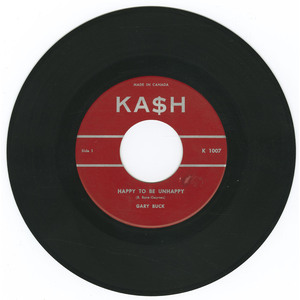Buck, Gary
Websites:
No
Origin:
Thessalon, Ste. Marie, Kitchener, Ontario - Didsbury, Alberta, 🇨🇦
Biography:
Gary Ralph Buck was born on 21 March 1940 in the small northern Ontario town of Thessalon and grew up in nearby Sault Ste. Marie, where music and opportunity arrived through the airwaves long before they arrived on vinyl. As a teenager he became a regular presence on CKCY radio, singing with Ray Kovisto’s Country Caravan and learning the craft the way most Canadian country musicians did in the 1950s: live on the air, in front of a microphone, with no room for error. He had the voice, the poise, and the polish early, but he also had something harder to teach — drive. For a brief period he pursued semi-pro baseball, yet music kept pulling him back, and by nineteen he was recording in Toronto for the Canatal label, beginning what would become one of the most varied and influential careers in Canadian country music.
Buck made history in 1963 when his single Happy to Be Unhappy — released in the United States on the Petal label — shot to number one on the Cashbox country chart and broke into Billboard's national listings. It placed him among the very few Canadians of the era, alongside Hank Snow and Myrna Lorrie, to enter the American country mainstream. Cashbox named him Newcomer of the Year, and suddenly a young man who had started out on northern Ontario radio was an international prospect. The follow-up was equally strong. The Wheel Song brought him a second U.S. hit in 1964, and throughout the rest of the decade and into the early 1970s he remained a chart force in Canada with The Weather Man, Break the News to Lisa, Mr. Brown, Wayward Woman of the World, It Takes Time, Saunders’ Ferry Lane, and What’ll I Do. His singles routinely landed in the top tier of the RPM country charts, and his output spanned everything from honky-tonk and Nashville balladry to storytelling pieces and ambitious pop-country crossovers. He wrote and recorded countless commercial jingles as well, a behind-the-scenes craft that quietly defined the era.
By the mid-1960s Buck had relocated to Kitchener, Ontario, where he became a household name on The Gary Buck Show on CKCO-TV. The series ran from 1967 to 1969 and further established him as one of the few Canadian artists with both chart credibility and television visibility. He appeared frequently on Canadian and American country television specials, and had the distinction of performing several times at the Grand Ole Opry in Nashville during the late 1960s and early 1970s. Even as he remained an active recording artist deep into the 1990s — releasing albums such as Western Swing and Country in 1998 and the gospel project Don’t Be Standin’ on the Outside in 2002 — Buck was increasingly influencing the industry from behind the console and behind the desk.
As a producer he was prolific, trusted, and in demand. Over the course of several decades he worked with George Hamilton IV, Dallas Harms, Dick Damron, the Family Brown, Tommy Hunter, the Mercey Brothers, Al Cherny, Wayne Rostad, Billie Jo Spears, Johnny Duncan, Gene Watson, and many others. His ear for material was sharp, and his reputation for clean, radio-ready production made him a first-call figure across Canada. His own songs were picked up by a wide range of performers — from Bobby Curtola in the pop world to Orval Prophet, Donna Darlene, and his frequent collaborators in the country field. He recorded more than fifty singles and released albums on Canatal, Petal, Capitol, Tower, RCA Camden, and Broadland, leaving behind a catalogue that touched almost every corner of the country genre.
What truly set Gary Buck apart, however, was his work as a builder. In 1970 he became general manager of Capitol Records’ publishing wing, Beechwood Music, a position in which he championed and launched several career-shaping songs. He was instrumental in the early success of Anne Murray’s Snowbird, as well as in the placement of Dallas Harms’ Paper Rosie and Dick Damron’s Countryfied, both of which found major audiences through George Hamilton IV and Gene Watson. Recognizing the need for Canadian infrastructure, Buck founded Broadland Music in 1971. The label and publishing house immediately became a home for Don Cochrane, Alex Fraser, Dallas Harms, Patti MacDonnell, Artie McLaren, Orval Prophet, Ian Tyson, and others. By the time Quality Records acquired a controlling interest in 1976, Broadland had already become a cornerstone of the Canadian country business.
After the collapse of Quality in 1985, Broadland lay dormant for a few years until Buck revived it as Broadland International in Nashville in 1990. Its roster leaned increasingly American and included George Hamilton IV, but its mission remained centred on Canadian talent. Buck operated out of studios and offices in both Nashville and Calgary, continuing to produce records for U.S. and Canadian artists alike. His work on behalf of Canadian musicians extended into industry leadership. He served five terms as international director of the Country Music Association in Nashville, beginning in 1970 and ending with his final term in 1990. In 1976 he co-founded what would become the Canadian Country Music Association, providing the first major, lasting organizational structure for the genre in Canada. He later founded the Canadian Country Music Hall of Fame, which began inducting members in 1984, opened its first physical space in Kitchener in 1989, and eventually moved to Calgary in 1999. Buck served as the Hall’s president and was inducted himself, in both the artist and builder categories, in 2001.
Until the very end of his life Buck remained actively engaged in recording, producing, and mentoring. He continued to split his time between Nashville and Alberta, nurturing new artists and preserving the careers of established ones. Even while battling cancer in his final years, he pursued projects with the same steady dedication that had defined his entire career. He died in Didsbury, Alberta, on 14 October 2003, leaving behind a legacy unmatched in its breadth. Few Canadians shaped country music as completely — as performer, songwriter, producer, label founder, publisher, executive, administrator, advocate, and ambassador. Gary Buck helped build the systems that allowed Canadian country artists to thrive, and he did it while making records that continue to resonate with audiences across generations.
-Robert Williston




















